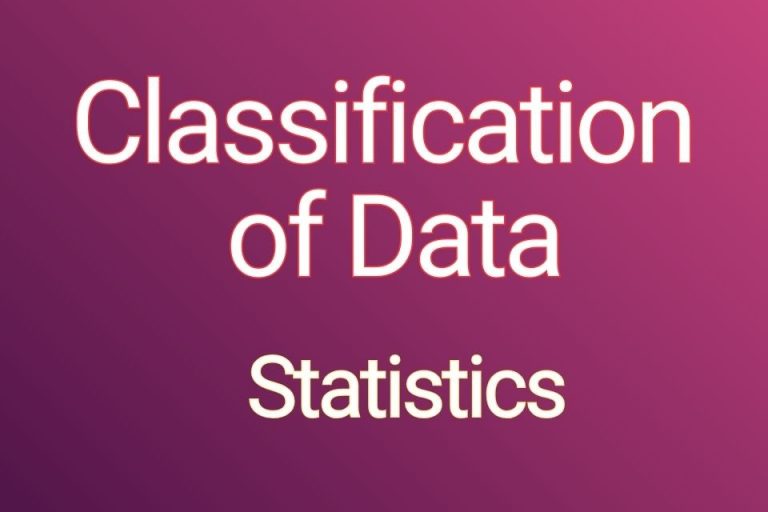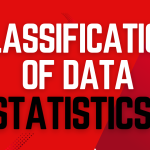Table of Contents
1. Introduction
Statistics is all about data. To study, analyze, and interpret data, it must be organized systematically. This organization is called Classification of Data.
Definition: Classification of Data is the process of arranging raw data into groups or categories based on common features.
Hindi Term Hint: वर्गीकरण (Vargikaran)
Example:
- Marks of students (0–20, 21–40, 41–60, 61–80, 81–100)
- Age groups in a city (0–10, 11–20, 21–30…)
2. Need / Importance of Classification
- Simplifies large data sets
- Makes data easy to analyze and compare
- Helps in drawing graphs and charts
- Provides meaningful insights from raw data
3. Objectives of Classification
- To systematize data
- To make comparison easier
- To help in presentation of data (tables, graphs)
- To find patterns, trends, and relationships
4. Principles of Classification
- Mutually Exclusive Classes: Each data item should fit in only one category.
- Exhaustive Classes: All data must be included in some class.
- Homogeneity: Items in a class should be similar.
- Consistency: The classification should be uniform throughout.
5. Types of Classification
A. Qualitative Classification (Categorical Data)
- Based on attributes or qualities
- Cannot be measured numerically
- Answers “Which category?”
Subtypes:
| Type | Meaning | Example |
|---|---|---|
| Nominal | Names/labels, no order | Gender: Male/Female, Blood Group: A/B/O/AB |
| Ordinal | Categories with order | Education Level: High School < Bachelor < Master < PhD |
Hindi Terms: गुणात्मक, नाममात्र (Nominal), क्रमबद्ध (Ordinal)
B. Quantitative Classification (Numerical Data)
- Based on numbers
- Can be counted or measured
- Answers “How many?” or “How much?”
Subtypes:
| Type | Meaning | Example |
|---|---|---|
| Discrete | Countable numbers only | Number of children, Number of books |
| Continuous | Can take any value (including fractions) | Height, Weight, Marks |
Hindi Terms: परिमाणात्मक, पूर्णांक (Discrete), निरंतर (Continuous)
6. Classification Based on Measurement Scale
| Scale | Meaning | Example |
|---|---|---|
| Nominal | Names/labels, no order | Color of cars: Red, Blue |
| Ordinal | Ordered categories | Rank in a race: 1st, 2nd, 3rd |
| Interval | Equal intervals, no true zero | Temperature in °C |
| Ratio | True zero exists, arithmetic possible | Weight, Height, Age |
7. Advantages of Classification
- Simplifies analysis of large data
- Helps in better understanding
- Useful for tables, graphs, and charts
- Enables comparisons and decision-making
8. Limitations of Classification
- May lead to loss of information if too generalized
- Improper classification may give misleading results
- Too many classes can confuse the reader
9. Practical Example
| Name | Age | Gender | Marks in Math |
|---|---|---|---|
| Alice | 12 | Female | 85 |
| Bob | 13 | Male | 90 |
| Charlie | 12 | Male | 78 |
| Diana | 14 | Female | 92 |
Classification:
- Qualitative Data: Name, Gender
- Quantitative Data: Age, Marks
- Discrete Data: Age, Marks (whole numbers)
- Continuous Data: Marks (if decimals included)
10. Differences – Qualitative vs Quantitative
| Feature | Qualitative | Quantitative |
|---|---|---|
| Based on | Attributes/qualities | Numbers/measurements |
| Examples | Gender, Blood group | Age, Marks |
| Measurement | Cannot be measured | Can be measured |
| Subtypes | Nominal, Ordinal | Discrete, Continuous |
11. MCQs (Exam-Oriented)
Q1: Classification of data means:
(a) Collecting data
(b) Organizing data into groups ✅
(c) Analyzing data
(d) Tabulating data
Q2: Religion-wise population classification is:
(a) Quantitative
(b) Qualitative ✅
(c) Continuous
(d) None
Q3: Age-wise grouping is:
(a) Qualitative
(b) Quantitative ✅
Q4: Which is discrete data?
(a) Height
(b) Weight
(c) Number of children ✅
(d) Temperature
Q5: Education level (High School < Bachelor < Master) is:
(a) Nominal
(b) Ordinal ✅
12. Short Questions Answers
Q1: Define classification of data.
A: Classification of data is arranging raw data into groups or categories to simplify analysis and understanding.
Q2: List the types of classification with examples.
A:
- Qualitative: Gender (Male/Female), Blood group (A/B/O/AB)
- Quantitative: Age (10, 12, 15), Number of books (5, 10, 15)
Q3: What is the difference between discrete and continuous data?
A:
- Discrete = Countable (e.g., Number of students)
- Continuous = Measurable, can take fractions (e.g., Height in cm)
Q4: Why is classification important in statistics?
A: It organizes data, helps in analysis, enables pattern recognition, and facilitates graphical representation.
Q5: Give an example of ordinal data.
A: Education Level – High School < Bachelor < Master < PhD
Q6: Give an example of nominal data.
A: Blood Group – A, B, O, AB
13. Long Answer Questions (with Answers)
Q1: Explain the principles of classification with examples.
A:
- Mutually Exclusive: Each item belongs to one category (e.g., student cannot be both Male & Female).
- Exhaustive: All items included (e.g., all students’ ages included in groups 10–12, 13–15).
- Homogeneity: Items in a class similar (e.g., marks 80–90 in one group).
- Consistency: Uniform method of classification applied throughout dataset.
Q2: Discuss advantages and limitations of classification.
A:
- Advantages: Simplifies data, helps in comparison, makes analysis easy.
- Limitations: Generalization may lose details, improper classification may mislead, too many classes may confuse.
Q3: Explain different measurement scales with examples.
A:
- Nominal: Names, no order (Color: Red, Blue)
- Ordinal: Ordered categories (Rank: 1st, 2nd, 3rd)
- Interval: Equal intervals, no true zero (Temperature in °C)
- Ratio: True zero, arithmetic possible (Weight in kg)
Q4: Compare qualitative and quantitative classification.
A:
| Feature | Qualitative | Quantitative |
|---|---|---|
| Based on | Attributes | Numbers |
| Measurement | Cannot measure | Can measure |
| Examples | Gender, Blood Group | Age, Height |
| Subtypes | Nominal, Ordinal | Discrete, Continuous |
14. FAQs (Minimum 10, Schema Optimized)
14. FAQs (continued – fully expanded, 10+ questions)
- Q: Why is classification of data important in statistics?
A: It organizes raw data, simplifies analysis, helps in comparison, and aids in graphical presentation. - Q: What are the main types of data classification?
A: Two main types – Qualitative (Categorical) and Quantitative (Numerical). - Q: Give examples of qualitative data.
A: Gender (Male/Female), Blood Group (A/B/O/AB), Religion (Hindu/Muslim/Christian). - Q: Give examples of quantitative data.
A: Age (10, 12, 15), Marks (85, 90, 78), Height (150 cm, 160 cm). - Q: What is nominal data?
A: Data with labels/names without order. Example: Types of fruits – Apple, Mango, Banana. - Q: What is ordinal data?
A: Data with a specific order but no exact difference between categories. Example: Education level – High School < Bachelor < Master. - Q: Difference between discrete and continuous data?
A:- Discrete: Countable numbers only (Number of students, Number of books)
- Continuous: Measurable, can take fractions (Height, Weight, Temperature)
- Q: What are the four measurement scales in statistics?
A: Nominal, Ordinal, Interval, Ratio - Q: Give examples of interval and ratio scales.
A:- Interval: Temperature in °C – 20°C, 25°C
- Ratio: Weight – 40 kg, 50 kg; Age – 12 yrs, 15 yrs
- Q: Can classification of data be used for exam preparation?
A: Yes, it helps in organizing important concepts, spotting patterns, and simplifying large datasets for practice questions. - Q: How does classification help in graphical representation?
A: It groups similar data together, making it easier to plot bar graphs, histograms, pie charts, and frequency distributions. - Q: What mistakes should be avoided in data classification?
A:- Overlapping classes (violates mutual exclusivity)
- Leaving out data (not exhaustive)
- Using inconsistent methods across dataset
- Q: What is the difference between qualitative and quantitative data?
A:- Qualitative: Based on qualities/attributes, cannot measure numerically (Gender, Blood Group)
- Quantitative: Based on numbers, measurable (Age, Marks, Height)
- Q: Provide an example where both qualitative and quantitative data are present.
A: Student data: Name (Qualitative), Age (Quantitative), Gender (Qualitative), Marks (Quantitative)
Internal Links Suggestions:
External Links Suggestions:

